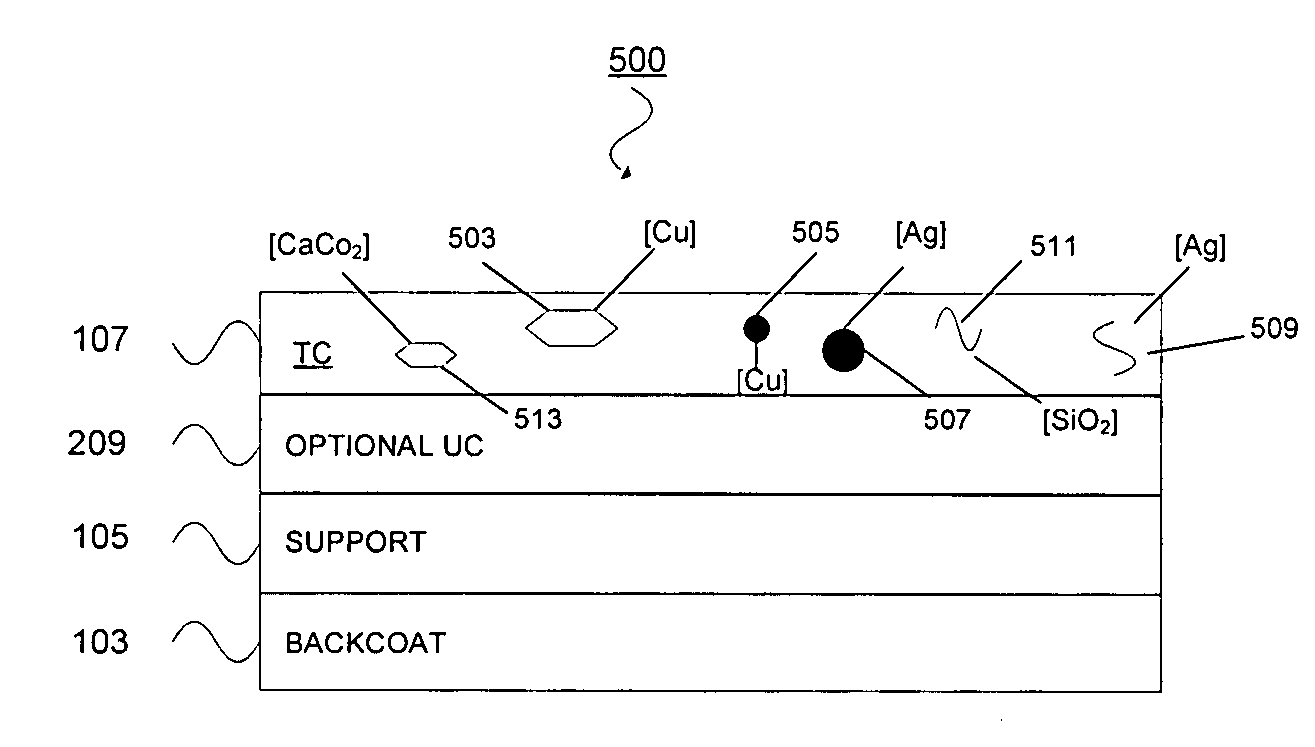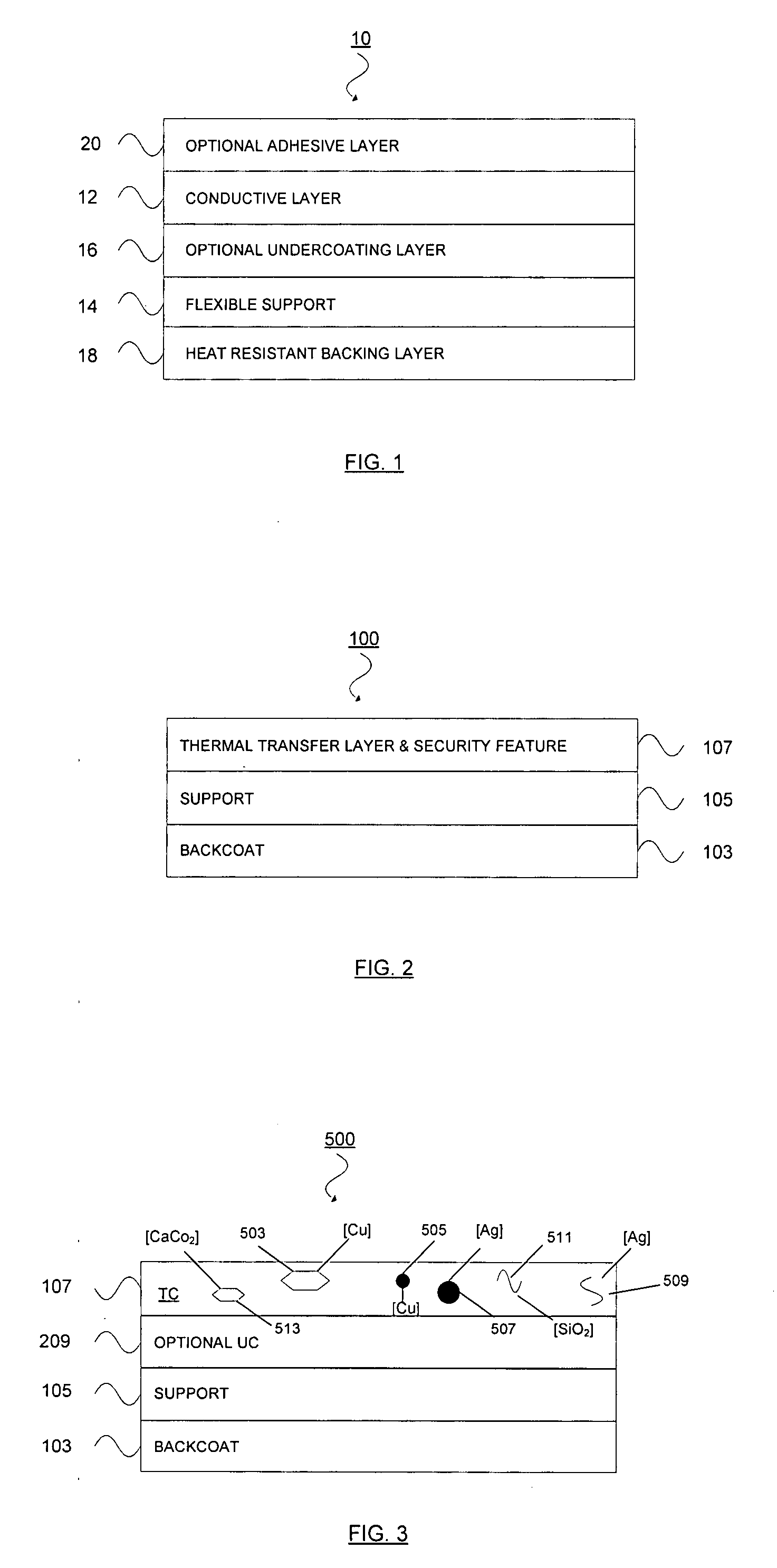Conductive thermal transfer ribbon
a thermal transfer ribbon and thermal transfer technology, applied in the direction of transfer patterning, thermal imaging, printing, etc., can solve the problems of unreliable or otherwise undesirable commercial scale production, high cost and production time of conventional means for forming electronic components on substrates, and high cost and production tim
- Summary
- Abstract
- Description
- Claims
- Application Information
AI Technical Summary
Benefits of technology
Problems solved by technology
Method used
Image
Examples
example 1
[0108]A thermal transfer ink was prepared by first heating 37.50 grams of solvent grade toluene (Chemcentral, Chicago, Ill.) to 70 C in a 2 oz glass jar on a combination hot plate and magnetic stirrer. A magnetic stir bar was then placed in the jar, and the stirrer was set to 300 rpm. 1.50 g of Unirez 2980 (a fatty acid dimer-based esteramide resin from Arizona Chemical, Jacksonville, Fla.), 0.19 g of Elvax 250 (an ethylvinylacetate copolymer from Chemcentral, Chicago, Ill.) and 0.18 g of Disperbyk 191 (a polyacrylate copolymer with pigment acidic groups from Dar-Tech, Cleveland, Ohio) were added to the solvent thus prepared, and the lid of the jar was set loosely on the jar to retard solvent evaporation. This mixture was left under heat and agitation for 10 minutes until the solution was homogenous. This solution was of a clear pale yellow color. The solution was then transferred to a half-pint paint can, and 35.63 g of S2-80 (spherical 80 nanometer silver particles from NanoDynami...
example 2
[0111]The procedure of Example 1 was substantially followed, with the exception that the Uni-Rez 2980 and the Elvacs 250 were replaced with 1.86 grams of Synthetic Resin AP (a acetophenone-formaldehyde-condensation resin from Dar-Tech, Cleveland, Ohio), 0.20 grams of Disperbyk 111 were used, 39.19 grams of the S280 silver material were used, and the coating weight for the conductive ink layer was 7.27 grams per square meter. The resulting print had a brownish color. The thickness of the printed ink was measured via scanning electron microscope to be 1.5 microns. Surface resistivity of the unprinted ribbon was in excess of 1,000,000 ohms per square. The resistivity of the printed image was 869,760 ohms / square. A soft cloth was then used to gently polish the print which turned a lustrous silver color. Surface resistivity was then measured on the polished print, and it was 3.00 ohms / square.
example 3
[0112]The procedure of Example 1 was substantially followed, with the exception that the ink used was comprised of 35.63 grams of C1-500 (spherical 0.50 micron copper particles obtained from NanoDynamics, Buffalo, N.Y.) in place of the S280 silver particles. The thermal transfer ink was coated at 7.38 grams per square meter. Thermally transferred prints from this ink developed no conductivity with the multimeter reading “overflow”; indicating an open circuit.
[0113]It was unexpected that copper, which has a conductivity similar to that of silver, produced a product with such poor conductivity.
PUM
| Property | Measurement | Unit |
|---|---|---|
| Temperature | aaaaa | aaaaa |
| Length | aaaaa | aaaaa |
| Length | aaaaa | aaaaa |
Abstract
Description
Claims
Application Information
 Login to View More
Login to View More - R&D
- Intellectual Property
- Life Sciences
- Materials
- Tech Scout
- Unparalleled Data Quality
- Higher Quality Content
- 60% Fewer Hallucinations
Browse by: Latest US Patents, China's latest patents, Technical Efficacy Thesaurus, Application Domain, Technology Topic, Popular Technical Reports.
© 2025 PatSnap. All rights reserved.Legal|Privacy policy|Modern Slavery Act Transparency Statement|Sitemap|About US| Contact US: help@patsnap.com


